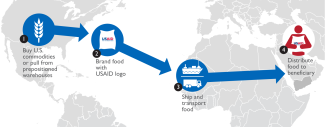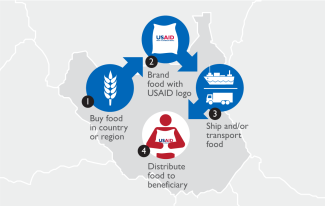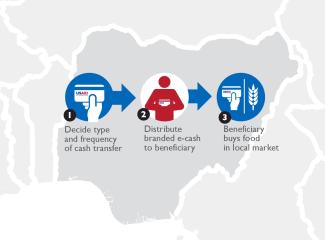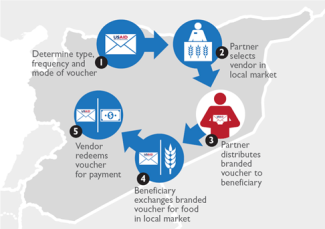USAID provides emergency food assistance to vulnerable populations affected by natural disasters such as droughts and floods, and in response to conflict. Response tools include U.S.-purchased food (“in kind” food aid) or food purchased in the affected country or region. It sometimes provides beneficiaries with cash or food vouchers so they can directly access food in their local markets. There is no one “right” way to aid hungry people. Interventions depend on food insecurity causes, the functioning of markets, security conditions, and overall program goals. Cost, local diet preferences, and timeliness are also factors.
U.S. In-Kind Food Aid
U.S. in-kind food aid (Title II) is often used to respond to an emergency where: 1. local markets are not functioning; 2. there isn’t enough food in local markets to meet need; or 3. beneficiaries do not have physical access to markets. A typical food basket can include a grain, a pulse, and oil, designed to mirror local diets as much as possible. This food aid takes an average of 4–6 months to reach beneficiaries. Early warning data and speed of delivery factor into final program decisions.
For example: Even before the 2015 conflict began, Yemen relied on imports for the vast majority of its food. Conflict hindered food access, creating the largest food security emergency in the world. USAID Title II in-kind food has been critical, helping partner WFP reach nearly 5 million people in FY 2017.


Local and Regional Purchase
Locally or regionally purchased commodities are often used when local or regional markets have adequate quantities of food available to supply emergency food assistance programs without impacting prices or commercial trade. Locally or regionally purchased food reaches beneficiaries within 1–2 months.
For example: When Title II commodities were more expensive and took longer to arrive, USAID’s partner WFP purchased food regionally for South Sudan, thus preventing gaps in the food pipeline and ensuring that the most vulnerable got the food they needed, when they needed it.

Cash Transfers for Food
Cash transfers and vouchers are often used when local markets have sufficient food and people simply can’t afford it. Cash transfers may be used when people are physically spread out or highly mobile, rapid response is high priority, or food needs are so severe people will spend most new income on food.
For example: In Nigeria, conflict related to Boko Haram creates internal displacement, reduces food access and disrupts livelihoods. In response, USAID provides cash transfers, among other modalities, to internally displaced persons and host communities. Cash-based assistance gives beneficiaries the ability to shop in local markets and buy food that is culturally familiar.

Food Vouchers
Vouchers may be used when working with specific vendors, ensuring people receive certain foods, or for security reasons. Vouchers can strengthen local markets by enabling participating local vendors to sell more food. Debit card or mobile phone cash transfers, as well as electronic vouchers may benefit local banks and mobile phone companies.
<>For example: USAID and partner WFP are providing assistance to Syrian refugees, primarily through electronic food vouchers. Vouchers are a reliable, timely and secure way to provide assistance to vulnerable individuals and families. It also allows recipients to tailor food assistance to their needs while supporting the local economy in refugee hosting areas.
